Say hello to the Strawberry Begonia, a delightful little plant with round hairy leaves and super thin pink runners that make it look like a strawberry plant.
(Spoiler alert: It’s not one!)
But what is it, then?
Let’s explore what Strawberry Begonia really is (hidden identity: revealed!) and provide you with must-know care tips for keeping your fruity-looking friend happy, healthy, and vibrant.
Table of Contents
Strawberry Begonia Plant Care Guide
History, Habitat, and Characteristics
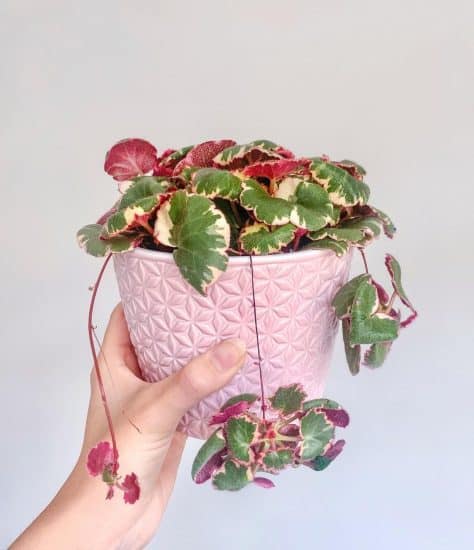
Meet the Strawberry Begonia (Saxifraga stolonifera), a charming plant that hails from the cliffs in temperate regions of Asia, including parts of Japan and China. Besides its role in the environment, it has a rich history of culinary and medicinal uses, too.
Don’t let the name fool you, though — this sneaky houseplant is neither a strawberry or a begonia. It belongs to the Saxifragaceae family, known for its hundreds of diverse, hardy species.
So, where did the Strawberry Begonia name come from? Well, it’s all thanks to its begonia-like leaves and thin runners that produce baby plantlets, reminiscent of a strawberry plant!
Note: Strawberry Begonia plants are also referred to as Mother of Thousands because of the many fleshy plants (or plantlets) that look like tiny strawberries at the end of their dangling leaf runners. It isn’t the same as the plants known as Mother of Thousands in the kalanchoe family, though.
At around 10 inches tall, the Strawberry Begonia is perfect for tabletops or hanging baskets. But given its fuzzy leaves with silver veins, it could add a dose of cute pizzazz to any space. Its hairy stems and pink trailing tendrils (in the running for prettiest leaf runners ever) are just the icing on the cake!
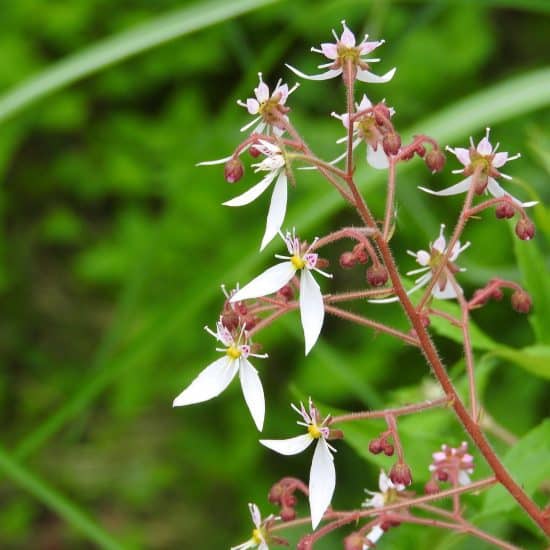
And when it blooms? You’ll be greeted by delicate small white flowers with touches of pink — about 30 tiny blossoms per stem!
Light
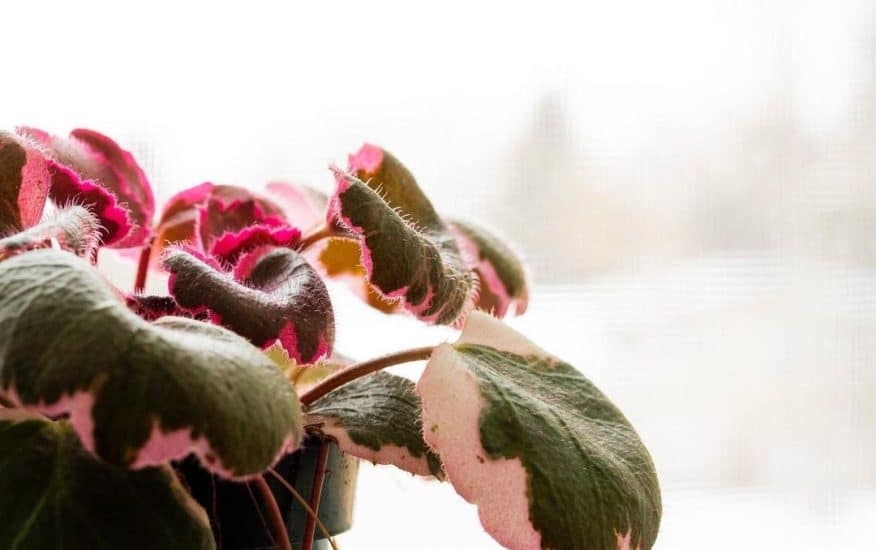
In their native habitat, the Strawberry Begonia plants thrive in damp, shady nooks of forests and rocky crannies. That makes it a great pick for lower light conditions in your home. Grow Strawberry Begonia somewhere that receives gentle, indirect sunlight, like a north- or west-facing window with morning or late afternoon sun.
If your Strawberry Begonia is getting too much light, its leaves might fade or scorch, even turning brown and becoming crispy. You might even spot small holes appearing on the leaves.
Also keep an eye out for signs that your plant is not receiving enough light, such as longer, weak stems that indicate it’s stretching out in search of the sun. It might also experience slow growth, or loss of color on the leaves.
Our light tips:
- Find a home for your Strawberry Begonia near an exposure where it can bask in bright, indirect sunlight, like a north- or west-facing window.
- To protect your plant from harsh direct sunlight, try using a sheer curtain as a filter in south- or east-facing windows, or move it to a slightly shadier spot.
- If your Strawberry Begonia seems to be craving more light, move it to a brighter spot or supplement the natural light with an artificial light source like an LED grow light (full-spectrum works well!).
Water
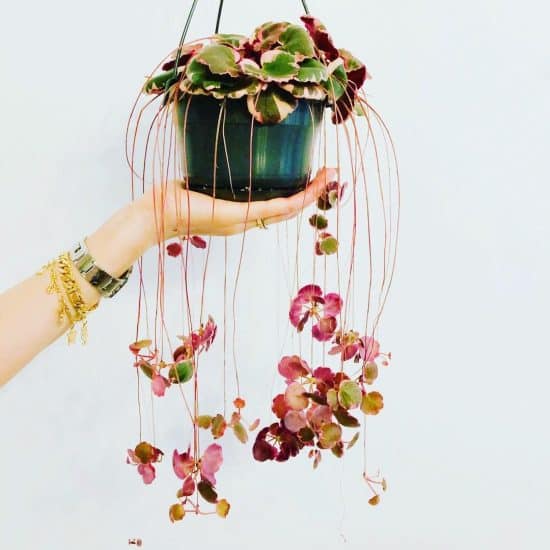
Finding that sweet spot when it comes to watering your Strawberry Begonia can be a bit tricky. These fleshy plants are sensitive to overwatering, which can lead to root rot, so you’ll want to provide adequate drainage and let the pot dry out a bit between waterings.
(Pro tip: Use a watering meter to keep track of the plant’s moisture levels. You’ll know it’s time to water when the indicator just reaches the red zone, showing that the soil is almost dry.)
When it’s time for Strawberry Begonia watering, make sure you give your plant a good soak right at the soil line. Avoid getting the leaves and stems wet, as this can cause them to rot.
Not enough water can cause wilting, along with crispy or shriveled leaves. If you notice these signs in your Strawberry Begonia, increase your watering frequency without going overboard.
Too much water can lead to yellowing leaves and mushy stems. In this case, cut back on the watering frequency and let your Strawberry Begonia dry out a bit more between waterings. If you’re using a plant tray, be sure to let the excess water drain through the pot rather than collecting in the tray.
Keep in mind that your watering frequency might need adjusting depending on the season and the plant’s growth — you might need to water less often during the cooler months when your Strawberry Begonia is growing more slowly.
Temperature and Humidity
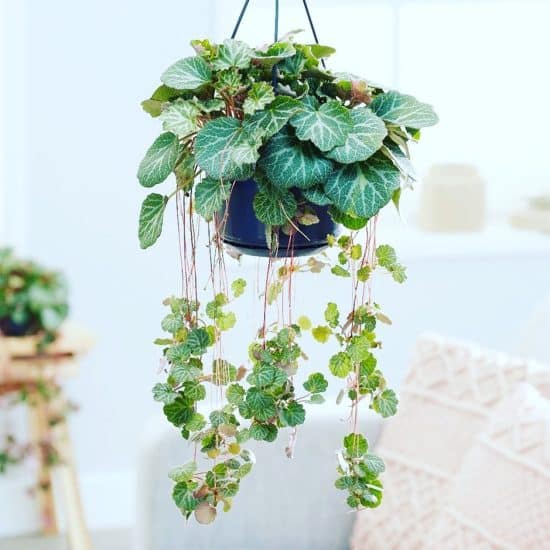
Strawberry Begonias, also known as creeping saxifrage and strawberry geranium, prefer cooler temperatures during the winter months. Aim for cool temperatures of 40-50°F in winter to keep your plant happy.
During the rest of the year, typical room temperatures of 65-80°F should be fine. When grown indoors, be cautious of exposing your Strawberry Begonia plant to extreme temperature fluctuations or cold drafts, though, since this can harm it.
Speaking of colder weather, your plant will go dormant during the winter months, but this is totally normal. In fact, it’s cold tolerant when grown outside and can bounce back even when temps reach 40°F.
Strawberry Begonia plants do well in an environment with a moderate to high humidity level of around 40-60%. Avoid higher humidity levels, which can lead to fungal disease or rot.
If the humidity level is too low for your Strawberry Begonia, you might notice brown leaf margins. In that case, try bringing the humidity up by using a pebble tray or humidifier.
Soil and Planting
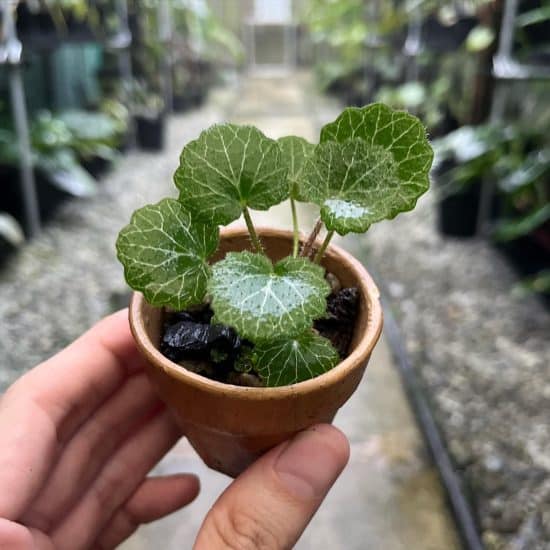
For planting Strawberry Begonias, we recommend using a standard potting mix with perlite and peat added to the mix. This combination gives your Strawberry Begonia plants the aeration, good drainage, and moisture retention their soil needs.
Make sure that its pot has holes at the bottom so that water can drain out — otherwise, water can become trapped around the roots and cause rot.
If you grow Strawberry Begonia in poor quality soil or a less than ideal potting mix, it may show signs of stress like yellowing leaves, slow growth, or a wilted appearance.
Repotting Strawberry Begonia plants will be an annual affair, since this one is a fast grower. Choose a pot that’s only a size larger than the current one, and make sure it has drainage holes!
Your Strawberry Begonia might start looking sparse in the middle or gets woody stems, which happens over time. When this happens, you can propagate plantlets from the mother plant and make a whole new one (we’ll cover this in the “Propagation” section below).
Strawberry Begonias may require occasional pruning to maintain their lush and compact appearance. Use a clean, sterilized pair of pruning shears or scissors to remove any leggy, overgrown, or diseased foliage. This will help your plant maintain a healthy look while also promoting new growth.
Fertilizer
Strawberry Begonia plants aren’t heavy feeders, so it’s important to avoid over-fertilizing them. Feed your plant once a month with a balanced liquid fertilizer at half-strength during its growing season (spring and summer) to maintain healthy growth.
If you notice that your Strawberry Begonia is wilting, has brown leaf tips, yellowing leaves, or a weak and leggy appearance, these could be symptoms of over-fertilizing. To resolve this issue, flush the potting mix with water to remove excess fertilizer salts, and reduce your fertilizer application.
Propagation
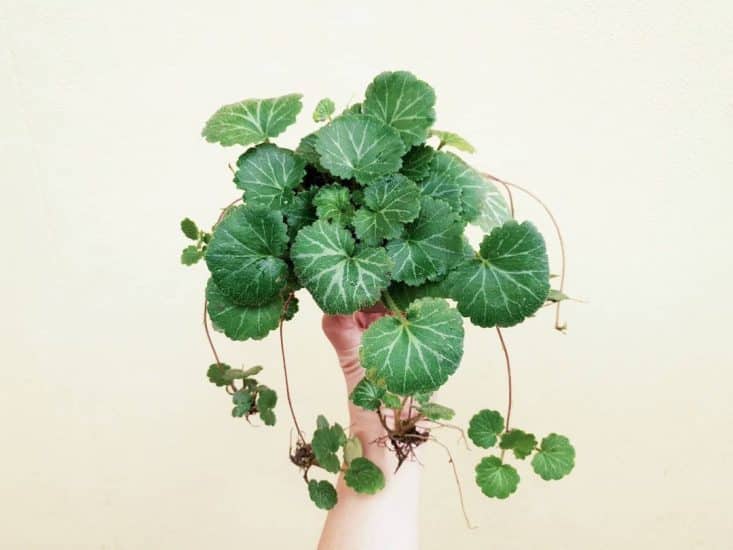
Let’s dive into the super fun and easy process of propagating Strawberry Begonia plants via runners. This method is a piece of cake, and soon you’ll be sharing new Strawberry Begonia plants with all your plant-loving buddies.
Tip: When you’re repotting Strawberry Begonia, it’s a great time to propagate as well, since doing both at once puts less stress on the plant.
Propagate Strawberry Begonia via runners:
- Find a happy runner: Look for a thin, thriving runner with a few small roots poking out. Make sure it has bright, healthy leaves with no signs of disease or decay.
- Give it a little dip: Gently detach the runner from the mother plant without hurting its precious roots. To stimulate rapid root growth and help your new plant get off to a good start, you might consider dipping the roots into a hormone-rich rooting powder (you can find this at most garden centers).
- Plant it in its new home: Grab a pot, making sure it has drainage holes, and fill it with well-draining potting mix. Make a hole in the center for your Strawberry Begonia runner, pop it in, and cover the roots. Pat the soil around it to make sure it’s snug and secure.
- Shower it with TLC: Place your new Strawberry Begonia in a bright spot and water it regularly, making sure the potting mix stays moist but not sopping wet. Once the plant is established, adjust your care to match the needs of its mother plant.
Common Issues

Yellow Leaves
This might be a sign of overwatering or poor drainage. If you have yellowing leaves on your hands, make sure you’re watering your Strawberry Begonia plants just right.
Remember to allow the top inch or so of the soil to dry out between waterings, and double-check that water drains all the way through the pot each time you give your Strawberry Begonia a drink.
Drooping Leaves
This might be a sign of underwatering or even poor drainage. If you notice your Strawberry Begonia’s leaves are drooping, check the soil and see if it’s dry. If it is, give your plant a nice drink, and then increase your watering frequency so that it retains a bit more moisture between waterings.
But what if the soil’s already moist? This could mean poor aeration around the roots due to soil compaction. In this case, try repotting your Strawberry Begonia using a potting mix with added perlite or pumice to ensure adequate drainage.
Pests and Diseases
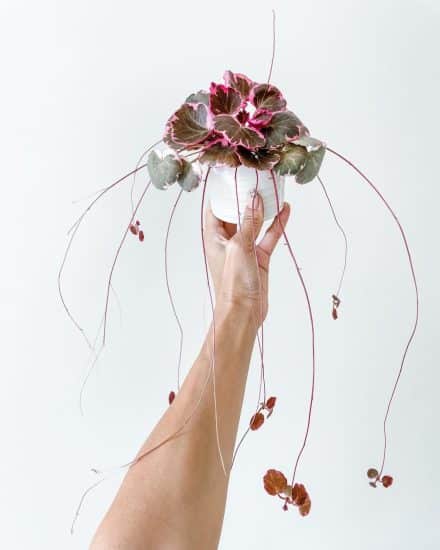
Strawberry Begonia care means sometimes dealing with common pests like mealybugs. But it’s not hard to keep them at bay.
Mealybugs
Tiny, white, fuzzy-looking bugs on your Strawberry Begonia plants are most likely mealybugs, a common pest that loves to snack on plant sap. This can stunt your plant’s growth and cause its leaves to wilt and turn yellow.
To treat mealybugs, mix equal parts water and rubbing alcohol in a spray bottle, and give your plant a good misting. Neem oil works great for controlling mealybugs too. It might take a few treatments over several weeks to totally get rid of them, but your plant will thank you for it!
In the meantime, keep your Strawberry Begonia away from your other plants to prevent these pests from spreading. To keep mealybugs away in the future, you can try wiping the leaves regularly with neem oil to deter them from moving in.
Root Rot
Root rot happens when your plant’s roots sit in soggy soil for too long, making them decay. If you notice yellowing leaves, wilting, and a not-so-pleasant smell coming from the soil, it’s time to do some investigating. Gently remove your Strawberry Begonia plant from its pot and take a look at its roots. If you see any slimy or mushy roots, take action right away.
Grab some sterilized scissors or pruning shears and trim away the rotten roots. Then, give your Strawberry Begonia a new start by repotting it using fresh potting mix that drains well, and cut back on your watering frequency.
Conclusion

That’s a wrap for our Strawberry Begonia care guide! Now you know why it’s named after a fruit and a begonia, but is actually neither. Great party conversation starter! (Or not. Entirely your call).
Strawberry Begonia care summary:
- Choose a location with bright, indirect light for your plant.
- Water your plant thoroughly each time, but be sure to allow the soil to partially dry out between waterings.
- Keep your plant in temperatures of 65-80°F for most of the year and 40-50°F in winter months, and maintain humidity levels around 40-60%.
- Use a well-draining potting mix and a pot with drainage holes to prevent root rot and other soil-related issues.
- Fertilize your Strawberry Begonia once a month during the growing season, using a balanced liquid fertilizer at half-strength.
By following these care tips and promptly addressing any signs of stress or pests, you’ll ensure a thriving, happy strawberry geranium plant that will bring beauty and charm to your indoor space for years to come.
If this guide has been helpful for you, please share it with friends or fellow plant lovers! And, if you have any questions or thoughts to share, don’t hesitate to reach out to us.
Take care, and happy planting!
FAQ
Are Strawberry Begonias actual begonias?
Despite its misleading moniker, the Strawberry Begonia is not an actual begonia. This enchanting plant has begonia-like leaves, which is where the name comes from. The two are not related, with the Strawberry Begonia belonging to the Saxifragaceae family and true begonias to the Begoniaceae family.
Are Strawberry Begonias related to strawberry fruit?
Strawberry Begonias are not related to the delicious strawberry fruit we all know and love. The name stems from the plant’s growth habit, which features runners that produce plantlets, similar to how strawberry plants grow.


